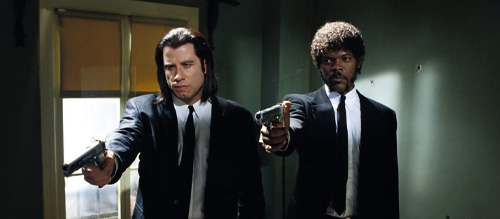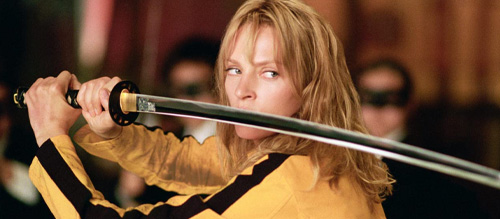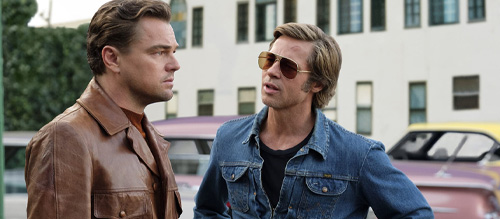Where to Start with Quentin Tarantino
There are few filmmakers who so seamlessly fuse such unrivalled talent, knowledge, controversy, and eccentricity as Quentin Tarantino. Deemed one of the most important directors of his generation, Tarantino is one of the most studied and discussed people in the film industry and has joined the pantheon of the most prominent directors of all-time; a list that includes Alfred Hitchcock, Steven Spielberg, and Martin Scorsese. His passion for cinema infuses everything he does, from his pastiche-fuelled oeuvre to his own film criticism, and his influences span global cinema and history.
Quentin Tarantino was born in Knoxville, Tennessee in 1963, and spent most of his youth in the Hollywood heartland… or just south of it in Torrance, Los Angeles County, California. He consumed cinema voraciously and cites numerous renowned filmmakers as influences on his work, such as Jean-Luc Godard, Sergio Leone, John Woo, and Brian De Palma. When asked in an interview whether he went to film school, Tarantino reportedly responded, ‘No, I went to films.’ This fact is evident in the abundance of cinematic and pop culture references that pervade the auteur’s body of work, which relies heavily on pastiche to pay homage to his favourite genres, from action and revenge movies to westerns, crime thrillers, Blaxploitation, and martial arts films. His auteurist style is also notable for his use of extreme violence and gore, non-linear narrative structures, and dark humour.
The acclaimed director has earned a devoted cult following and dozens of awards, including seven Academy Awards and the Palme d’Or at the Cannes Film Festival. However, he is not without his controversies and detractors. Over the years, he has engaged in public altercations with other members of the entertainment industry, including David Letterman and Spike Lee, the latter of whom has denounced Tarantino for his depiction of Black history and culture and his overuse of racial slurs (though his work has been supported by others, including Samuel L. Jackson). More recently, the director has faced criticism for his ties to film producer Harvey Weinstein. In a 2017 interview with Jodi Kantor at The New York Times, Tarantino expressed regret over his working relationship with the convicted sex offender, saying, ‘I knew enough to do more than I did.’ Despite these concerns, he has directed some of the most acclaimed films in the past 30 years and has worked with eminent stars like Jackson, Uma Thurman, Kurt Russell, Brad Pitt, and Leonardo DiCaprio.
One of Tarantino’s most publicized quirks is that he plans to direct only 10 films in his career and, according to Borys Kit at The Hollywood Reporter, sources say the filmmaker’s final work, The Movie Critic, is currently in pre-production. Though his filmography may be comparatively short, each film is carefully crafted, making this recommendation difficult to pin down. All of his movies could have made it somewhere on this list, but here at The Film Magazine we have curated three entry points that embody the auteur’s exceptional style, guiding you on Where to Start with Quentin Tarantino.
1. Pulp Fiction (1994)

Hot off the success of his first feature film, Reservoir Dogs, in 1992, Quentin Tarantino embarked on an ambitious new script, a narrative with a non-linear structure based on the popular pulp magazines and B-movie genres of the 1940s and 1950s.
Pulp Fiction follows two major storylines: the first involves hitmen Vincent Vega (John Travolta) and Jules Winnfield (Samuel L. Jackson) who commit crimes and enact violence for their boss Marsellus Wallace (Ving Rhames); the second follows boxer Butch Coolidge (Bruce Willis), who Wallace bribes to throw a fight. The impressive ensemble cast is rounded out by Uma Thurman, Harvey Keitel, Tim Roth, and Christopher Walken.
The film premiered at the Cannes Film Festival, winning the coveted Palme d’Or and garnering largely positive reviews for its originality, self-reflexivity, and almost blasphemous treatment of the Hollywood narrative formula. 1994 was a strong year for cinema, which saw the release of critically acclaimed and popular films like Forrest Gump, The Lion King, and Four Weddings and a Funeral. In contrast with these beautiful but classic films, Tarantino’s sophomore picture obliterates the traditional storytelling format familiar to mainstream audiences at the time. The film demonstrates the filmmaker’s unique talent for creating something that feels familiar due to its homage to pop culture and media, and yet is completely new and has never been done before.
The film’s indelible legacy and influence are undeniable. Some of the most lasting images in cinematic history are scenes from Pulp Fiction, like Vincent and Mia’s dance at a ‘50s-inspired restaurant, and the film is the embodiment of Tarantino’s bloody, indelicate auteurist style. Many critics and theorists have also identified Pulp Fiction as the pinnacle of postmodernism with its display of irreverence, parody, irony, moral relativism, deconstruction, and pastiche. According to Larry Fitzmaurice at Vulture, the memorable dance scene was inspired by Disney’s The Aristocats and the spontaneous dance in Godard’s Bande à part. Jules’s famous monologue paraphrasing the Bible verse Ezekiel 25:17 makes us question the morality and (in)justice of violence. And thanks to Travolta’s Vincent, we now know how to order a ‘Royale with cheese’ at a Parisian McDonald’s.
2. Kill Bill: Volumes 1 & 2 (2003-2004)

Even more violent than the previous film, Kill Bill Volumes 1 & 2 are a bloody love letter to the tropes and styles of martial arts and samurai films. We recommend considering these films as one since the saga was originally written as one long feature and Miramax advised Tarantino to release the films in two parts.
Together, the Kill Bill films follow ex-assassin ‘the Bride’ (Uma Thurman) as she seeks revenge on her former boss, Bill (David Carradine), and his band of assassins who massacred her wedding. On her quest to find and kill Bill, she travels across the United States to Japan and back again, meeting and fighting her enemies: Vernita Green (Vivica A. Fox), O-Ren Ishii (Lucy Liu), Budd (Michael Madsen), and Elle Driver (Daryl Hannah). The films are a stunning display of Quentin Tarantino’s mastery of technique and style, but they are not for the squeamish or faint of heart.
Just like his earlier films, Kill Bill has received universal acclaim. Critics argue that while the two films might lack some depth in the story, they more than make up for it with their masterful skill and intentional homage to spaghetti westerns, slasher horrors, and East Asian swordplay films. Volume 1 is unique for its anime-inspired scene, directed by Kazuto Nakazawa, which provides O-Ren Ishii’s backstory, and in a bid for legitimacy within martial arts cinema Tarantino contracted the skills of fight choreographer Yuen Woo-Ping, a Hong Kong cinema alum who also worked on Crouching Tiger, Hidden Dragon and The Matrix. The final fight scene in Volume 1 is particularly notable for its thoughtful design in a two-storey Tokyo restaurant complete with a glass floor and blue lighting glowing through shoji walls, mobile camerawork, and practical effects that contrast the crimson fountains of blood with the yellow of the Bride’s Bruce Lee-inspired jumpsuit.
It’s worth considering where Tarantino lands on the line between cultural appreciation and appropriation. Since his tongue-in-cheek wit is frequently applied to his genre parody and pastiche, it could appear that he almost makes fun of the sometimes campy tropes found in martial arts films, specifically in the training montage with kung fu master, Pai Mei (Gordon Liu), in Volume 2. However, the director pulls from a long history of cultural exchange between Eastern and Western cinema. Akira Kurosawa famously based his film Yojimbo on American film noir and westerns, which then inspired Sergio Leone’s Clint Eastwood vehicle, For a Fistful of Dollars. Tarantino is the poster boy for finding inspiration in an expansive array of different genres and global cinemas and has been vocal about his admiration for East Asian directors like the Hong Kong-based Shaw Brothers. It’s important to review his work critically, but it seems safe to say that his intentions in making Kill Bill were genuine.
3. Once Upon a Time… in Hollywood (2019)

This award-winning tribute to the glamour, chaos, and tragedy of 1960s Hollywood is Quentin Tarantino’s most recent film and his ninth entry into his limited oeuvre. Like some of his other films before it, namely Inglourious Basterds (2009) and Django Unchained (2012), Once Upon a Time… in Hollywood is a revenge-fuelled revisionist history film based on real events and people. Fictional TV star Rick Dalton (Leonardo DiCaprio) and his stunt double, Cliff Booth (Brad Pitt), try to salvage the former’s failing acting career in a rapidly changing industry full of fresh talent and hippies. The two friends’ lives intersect with a number of fascinating historical figures, including Sharon Tate (Margot Robbie), Roman Polanski (Rafał Zawierucha), Bruce Lee (Mike Moh), Steve McQueen (Damian Lewis), and the heinous Manson Family. In this retelling of the Tate murders, however, the young mother and burgeoning actress survives, and our heroes get their happy ending.
The film, which Tarantino referred to as his ‘Magnum Opus’ during its early stages, fits that description as his most comprehensive work that fully embodies his auteurist style and worldview. Beyond the dozens of historical recreations of famous movie stars and infamous events, the film’s title itself is an homage to Sergio Leone’s westerns Once Upon a Time in the West and Once Upon a Time in America. Tarantino parodies western tropes and turns hippie-era Hollywood into its own Wild West where Dalton and Booth can save the day as modern cowboy heroes. The film is also peppered with real archival footage of numerous films, including The Great Escape and The Wrecking Crew, starring Tate. Eagle-eyed fans and critics have even noticed references to Tarantino’s own movies like Pulp Fiction and Inglourious Basterds, making this his most self-reflexive film yet. And of course, there’s his trademark violent excess, which he reserves until the finale to exact revenge on the Manson Family murderers, ‘Tex’ (Austin Butler), ‘Katie’ (Madisen Beaty), ‘Sadie’ (Mikey Madison), and ‘Flowerchild’ (Maya Hawke).
Critics and audiences were split on the divisive ending and the subject matter more generally. While the film still garnered wide acclaim, as well as eight Oscar nominations and two wins for Best Supporting Actor and Best Production Design, some felt that the setting was exploitative and, according to Caspar Salmon at The Guardian, unnecessarily ‘gruesome.’ Johnny Brayson at Bustle reported that Tate’s sister, Debra, was initially against the idea of the film, but after meeting with Tarantino revealed that she was happy with the script. In the end, revenge-fuelled revisionism comes with the director’s territory. It’s an integral part of his style and worldview and, no matter how violent, he’s always aligned against the morally repugnant and evil villains of history.
Recommended for you: Quentin Tarantino Movies Ranked
Quentin Tarantino is not for everybody. The qualities that many audiences find exhilarating, unapologetic, and creative are too severe, bloody, and offensive for others. Both sides are right. As Hollywood becomes more sensitive to its treatment of people and stories on and offscreen, a director who plays by his own rules and often breaks them is starting to appear out of place. But it’s this risk-taking, confident, dissident attitude that has made him a force to be reckoned with in an often formulaic industry. His technique and style are of an irrefutably high quality and his passion for cinema is infectious. Tarantino’s postmodernist pastiche, self-reflexivity, and even stylized violence rewards film buffs whose tastes are as broad and varied as his own. And thus he remains one of the most interesting and innovative directors of our time.

